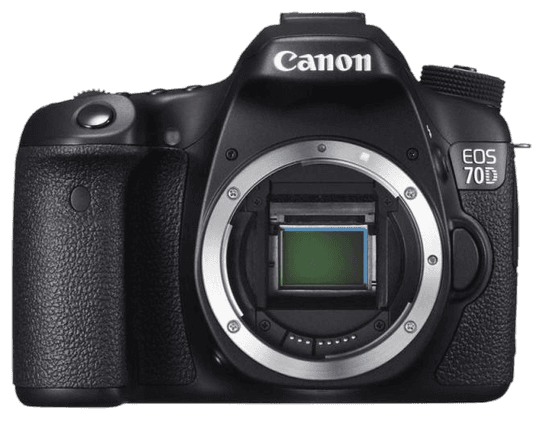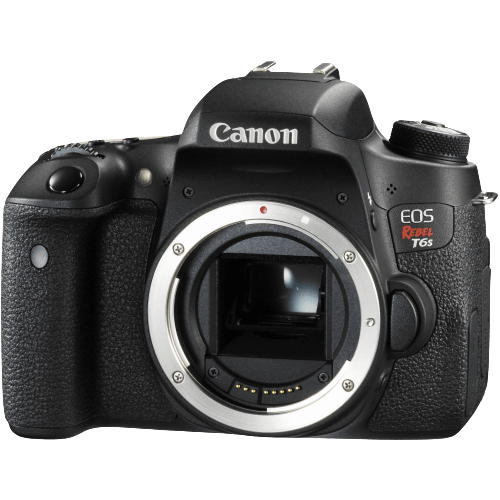Canon EOS 70D vs EOS Rebel T6s / 760D Comparison
Canon EOS 70D

Canon EOS Rebel T6s / 760D

The Canon EOS 70D outperforms the Canon EOS Rebel T6s / 760D with a score of 60/100 compared to 56/100. Both cameras are DSLRs, released in 2013 and 2015, respectively. They share similar dimensions, with the 70D measuring 139 x 104 x 79mm and the Rebel T6s at 132 x 111 x 78mm.
The 70D’s higher score stems from its better overall performance and features. However, the Rebel T6s has its advantages too, such as a lower launch price of $850 compared to the 70D’s $1199, and a lighter weight of 565g versus the 70D’s 755g.
Taking into account their scores, specifications, and prices, the Canon EOS 70D offers a slightly better camera experience, while the Canon EOS Rebel T6s / 760D provides a more budget-friendly and lightweight option.
Canon EOS 70D vs EOS Rebel T6s / 760D Overview and Optics
The Canon EOS Rebel T6s / 760D wins in terms of optics with a score of 59/100, while the Canon EOS 70D scores 58/100. Both cameras have common specifications like a CMOS sensor, APS-C sensor size, Canon EF-S lens mount, and no image stabilization.
The Rebel T6s / 760D has advantages in megapixels and the DXOMARK score for the sensor. With 24.2 megapixels, it captures more detail compared to the 20.2 megapixels of the EOS 70D. The T6s / 760D also boasts a higher DXOMARK score of 70, indicating better overall sensor performance than the EOS 70D, which has a score of 68. Additionally, the T6s / 760D features a more advanced processor, the Digic 6, which contributes to improved image processing and performance.
On the other hand, the Canon EOS 70D excels in shooting speed with 7 frames per second, compared to the 5 frames per second of the T6s / 760D. This makes the EOS 70D a better choice for capturing fast-moving subjects or action photography.
To sum up, the Canon EOS Rebel T6s / 760D outperforms the EOS 70D in terms of optics, with higher megapixels and a better DXOMARK score for the sensor. Its more advanced processor also provides improved image processing. However, the EOS 70D offers a faster shooting speed, making it a more suitable option for action photography.
Canon EOS 70D vs EOS Rebel T6s / 760D Video Performance
The Canon EOS 70D and the Canon EOS Rebel T6s / 760D both have a video score of 43 out of 100. This equal score means that the two cameras share similar video capabilities. Both cameras have a maximum video resolution of Full HD, with dimensions of 1920 x 1080. They also share the same maximum video frame rate of 30fps. Neither camera has built-in time-lapse functionality.
Although the two cameras have the same video score, there are some differences between them. The Canon EOS 70D offers better video autofocus performance, thanks to its Dual Pixel CMOS AF system. This system provides smoother and more accurate focus tracking during video recording, resulting in higher quality video footage. In addition, the 70D has a headphone jack for monitoring audio levels during video recording, which the T6s / 760D lacks.
On the other hand, the Canon EOS Rebel T6s / 760D has a few advantages over the 70D. It features a fully articulating LCD screen, which makes it easier to compose shots from different angles and monitor video recording. Additionally, the T6s / 760D has a slightly higher resolution sensor, which can result in slightly more detailed video footage.
Both cameras have their strengths and weaknesses when it comes to video capabilities. The Canon EOS 70D provides better autofocus performance and audio monitoring, while the Canon EOS Rebel T6s / 760D offers a more versatile LCD screen and a slightly higher resolution sensor. Ultimately, the choice between these two cameras will depend on the specific video needs and preferences of the user.
Canon EOS 70D vs EOS Rebel T6s / 760D Features and Benefits
The Canon EOS 70D emerges as the winner in the features category with a score of 70/100, while the Canon EOS Rebel T6s / 760D follows behind with a score of 57/100. Both cameras share several common specifications, which include a 3-inch screen size, 1,040,000-dot screen resolution, touchscreen functionality, flip screen, GPS absence, Wi-Fi connectivity, and lack of Bluetooth.
The Canon EOS 70D outperforms the Rebel T6s / 760D in some aspects. This superiority contributes to its higher feature score and makes it a better option for photographers seeking top-notch performance and functionality. Specific advantages of the EOS 70D over the Rebel T6s / 760D are not mentioned, but the higher score reflects its overall superiority in features.
On the other hand, the Canon EOS Rebel T6s / 760D does not surpass the EOS 70D in any specific features, as they share the same specifications mentioned above. However, the Rebel T6s / 760D may still appeal to some photographers due to its lower cost and similar specifications.
Both cameras offer impressive features and cater to photographers with varying needs and preferences. The Canon EOS 70D is the better option for those seeking superior performance, as reflected in its higher score. The Canon EOS Rebel T6s / 760D, while not outperforming the EOS 70D, remains a viable choice for budget-conscious photographers who still desire quality and functionality.
Canon EOS 70D vs EOS Rebel T6s / 760D Storage and Battery
The Canon EOS 70D outperforms the Canon EOS Rebel T6s / 760D in storage and battery with a score of 37/100, while the latter scores 24/100. Both cameras share similarities in storage, with one memory card slot each and compatibility with SD, SDHC, and SDXC memory cards.
The 70D has a superior battery life, offering 920 shots per charge, compared to the Rebel T6s / 760D’s 440 shots. The 70D uses an LP-E6 battery, while the Rebel T6s / 760D uses an LP-E17 battery. Neither camera supports USB charging.
In terms of storage and battery, the Canon EOS 70D is the clear winner with a longer battery life and a higher score. The Rebel T6s / 760D offers no significant advantages in this category. Choosing the Canon EOS 70D for its storage and battery capabilities is a wise decision.
Canon EOS 70D vs EOS Rebel T6s / 760D Alternatives
Still not ready to make a decision? Check out our other popular camera comparisons for inspiration:
